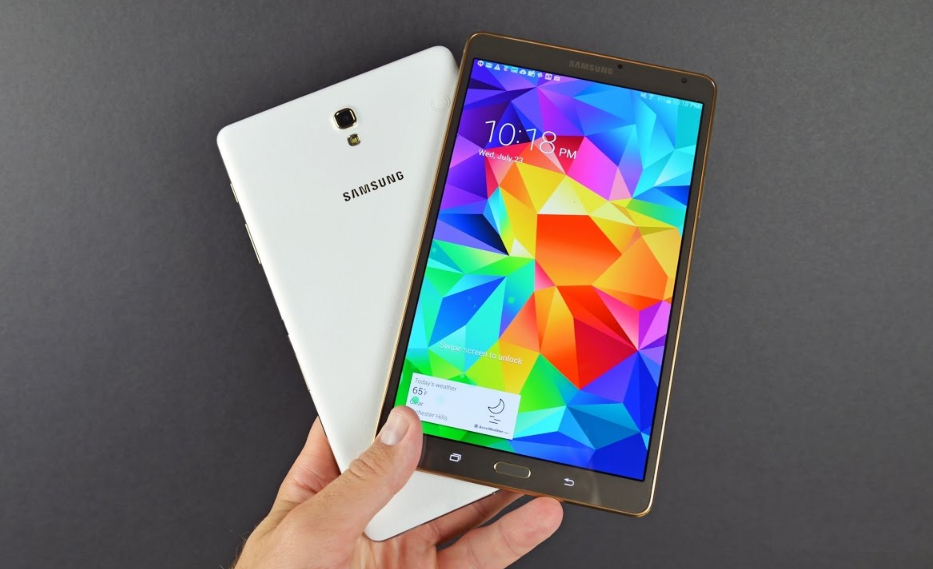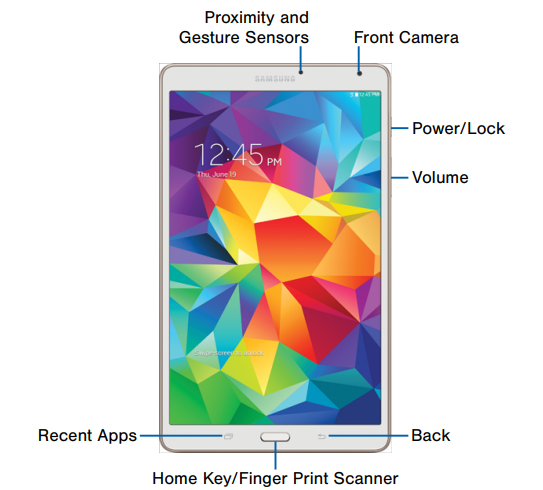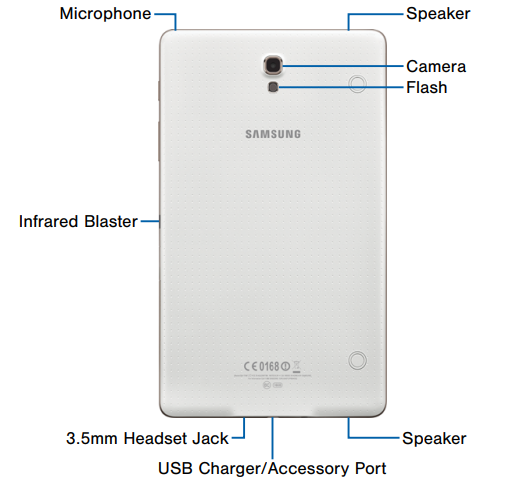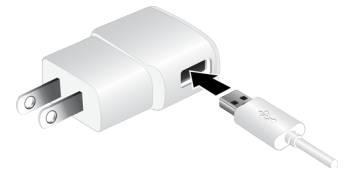Samsung Galaxy Tab S T700 User Manual | Setup Instructions

Content
Introduction
Introducing the Samsung Galaxy Tab S T700, a versatile and powerful tablet designed for all your entertainment, productivity, and connectivity needs. This device is perfect for both personal and professional use, offering a wide range of features and specifications that cater to a variety of purposes.
Detailed Specifications
The Samsung Galaxy Tab S T700 boasts a 10.5-inch Super AMOLED display with a resolution of 2560 x 1600 pixels, providing crisp and clear visuals. It is powered by a Qualcomm Snapdragon 888 processor and comes with 8GB of RAM and 128GB of internal storage, which can be expanded up to 1TB via a microSD card. The T700 features a dual camera setup with a 13MP primary lens and a 5MP secondary lens, as well as an 8MP front-facing camera for high-quality video calls and selfies. The device also supports fast charging and has a long-lasting 8,000mAh battery, ensuring uninterrupted usage throughout the day.
Getting Started
Front View

- Back: Tap to return to the previous screen, or to close a dialog box, menu, or keyboard.
- Front Camera: Take pictures and videos of yourself.
- Home Key/Finger Print Scanner: Tap to return to the home screen. Activate the Fingerprint security feature to use as a fingerprint reader.
- Power/Lock: Press and hold to turn the device on or off, or press to lock or wake up the screen. Press and hold to turn the device off or restart it, or for easy access to Airplane or Emergency Mode, and to Mute, Vibrate, and Sound modes.
- Proximity and Gesture Sensors: Detects the presence of objects near the device.
- Recent Apps: Tap to display recent apps, or touch and hold for home screen options.
- Volume: Press to adjust the volume of your device’s sounds.
Back View

- 3.5 mm Headset Jack: Connect an optional headset (not included).
- Camera: Take pictures and record videos.
- Flash: Illuminate subjects in low-light environments when taking a photo or recording video.
- Infrared Blaster: Controls external devices using infrared transmissions.
- Microphone: Records audio and detects voice commands.
- Speaker: Plays sounds, notifications, and audio.
- USB Charger/Accessory Port: Connect the Charger/USB cable (included), and other optional accessories (not included).
Description
The Samsung Galaxy Tab S T700 is a sleek and stylish tablet with a premium design and a slim profile. It has a lightweight build, making it perfect for on-the-go use. The device runs on the latest Android operating system and features Samsung's proprietary One UI, providing a seamless and intuitive user experience. The T700 is also compatible with the S Pen, allowing for precise and accurate input, making it ideal for artists, designers, and note-takers. With its powerful performance and versatile features, the Samsung Galaxy Tab S T700 is a top choice for anyone looking for a high-quality tablet.
Prepare Your Device
Charge the Battery
Your device is powered by a rechargeable, standard Li-Ion battery. A Wall/USB Charger (Charging Head and USB cable) is included with the device, for charging the battery. The battery comes partially charged. You must fully charge the battery before using your device for the first time. A fully discharged battery requires up to 4 hours of charge time. After the first charge, you can use the device while charging.
Warning: Use only Samsung-approved charging devices and batteries. Samsung accessories are designed to maximize battery life. Using other accessories may invalidate your warranty and may cause damage.
Your device comes with a charger (charging head and USB cable) to charge your device from any 110/220 VAC outlet.
- Insert the USB cable into the port.
- Connect the USB cable to the charging head, then plug the charging head into a standard AC power outlet.
When charging is complete, unplug the charging head from the power outlet and remove the USB cable from the device.

Caution Failure to unplug the wall charger before you remove the battery, can cause damage to the device.
When to Charge the Battery

- When the battery is weak and only a few minutes of talk time remain, the battery icon (
 ) blinks and the device sounds a warning tone at regular intervals. In this condition, your device conserves its remaining battery power, not by turning off the backlight, but by entering the dimming mode.
) blinks and the device sounds a warning tone at regular intervals. In this condition, your device conserves its remaining battery power, not by turning off the backlight, but by entering the dimming mode. - When the battery level becomes too low, the device automatically turns off.
For a quick check of your battery level, glance at the battery charge indicator located in the upper-right corner of your device’s display. Solid color ( ![]() ) indicates a full charge. You can also choose to display a percentage value. Having a percentage value onscreen can provide a better idea of the remaining charge on the battery.
) indicates a full charge. You can also choose to display a percentage value. Having a percentage value onscreen can provide a better idea of the remaining charge on the battery.
Set Up Your Device
Turn Your Device On and Off
- Turning the Device On
Press and hold the Power/Lock until the device vibrates and starts up. - Turning the Device Off
Press and hold the Power/Lock until the device vibrates and the Device Options menu displays.
At the prompt, tap Power off.
Setup Wizard
The first time you turn your device on, Setup Wizard will guide you through the basics of setting up your device. Follow the prompts to choose a default language, set up accounts, choose location services, and learn more about your device.
Secure Your Device
Use your device’s screen lock features to secure your device. To set a personal screen lock, use the Screen lock option.
- Lock the Device
By default, the device locks automatically when the screen times out.
Press the Power/Lock. - Unlock the Device
Unlock the device using one of the default unlock screens, or use Screen lock options for increased security.
Press the Power/Lock, and then drag your finger across the screen. Help
Set Up Accounts on Your Device
Google Account
Your new device uses your Google account to fully utilize its Android features, including Gmail, Google Hangouts, and the Play Store. When you turn on your device for the first time, set up a connection with your existing Google account, or create a new Google account. To create a Google account, or set up your Google account on your device, use Accounts settings.
- From the Home screen, tap
 Apps >
Apps >  Settings > Accounts.
Settings > Accounts.
Samsung Account
Create a Samsung account, for access to Samsung content and apps on your device. To create a Samsung account, or set up your Samsung account on your device, use Accounts settings.
- From the Home screen, tap
 Apps >
Apps >  Settings > Accounts.
Settings > Accounts.
Know Your Device
Warning: Please note that a touch screen responds best to a light touch from the pad of your finger or a non-metallic stylus. Using excessive force or a metallic object when pressing on the touch screen may damage the tempered glass surface and void the warranty.
Home Screen

- App Shortcuts: Shortcuts to your favorite applications on the Home screen.
- Apps Screen: Allows quick access to all of the Applications available.
- Home Screen Indicator: Indicates which Home screen is presently displayed.
- Status Bar: Display device status icons (right) and notification icons (left).
- Notifications Icons: Displays new messages and emails, notifications, available software updates, and so on.
- Status Icons: Display information about the device, such as the network signal strength, battery level, the time, and so on.
- Widgets: Self-contained onscreen applications (not shortcuts). These can be placed onto any of the available screens (Home or extended).
The Home screen is the starting point for using your device. Customize your home screen by adding application shortcuts, widgets, folders, and using wallpapers.
Manage Home Screens
Your device comes with multiple home screens by default, and you can additional screen. You can also rearrange the home screens in a different order.
- From a Home screen, pinch the screen.
Touch and hold an empty space on the screen. - Use these options to manage screens:
- Add a screen: Scroll to the end of the screens, and then tap Add.
- Remove a screen: Touch and hold on a screen, and then drag it to the Remove.
- Set a screen as the main home screen: Tap Main Home Screen at the top of a screen. This screen display when you press the Home Key.
- Change the order of screens: Touch and hold on a screen, and then drag to a new position.
App Shortcuts
You can use app shortcuts to launch an app from any home screen.
Add a Shortcut to a Home Screen
- From a Home screen, tap
 Apps.
Apps. - Touch and hold an app shortcut, and then drag it to a home screen and release it.
Remove a Shortcut
- Touch and hold a shortcut to release it.
- Drag the icon to the Remove icon and then release it.
Note: Removing a shortcut does not delete the app, it just removes the shortcut from the home screen.
Widgets
Widgets are self-contained apps that display on a home screen. Unlike a shortcut, a widget operates right on the home screen. There are all kinds of widgets, including links to a specific contact, Internet bookmarks, Gmail and email accounts, and many others.
Add a Widget to the Home Screen
- Touch and hold an empty space on the screen, and then tap Widgets.
- Touch and hold a widget, and then drag it to a home screen and release.
Remove a Widget
- From a Home screen, touch and hold a widget to release it.
- Drag the widget to the Remove icon and release it.
Note: Removing a widget does not delete the widget, it just removes the widget from the home screen.
Lock Screen
Choose settings for unlocking your screen.
- From the Home screen, tap
 Apps >
Apps >  Settings > Device tab.
Settings > Device tab. - Tap Screen lock to select a screen lock and level of security:
- Swipe: Swipe the screen to unlock it. This option provides no security.
- Pattern: A screen unlock pattern is a tap gesture you create and use to unlock your device. This option provides medium security.
- Fingerprint: Use fingerprint recognition to unlock the screen. This option provides medium to high security.
- PIN: Select a PIN to use for unlocking the screen. This option provides medium to high security.
- Password: Create a password for unlocking the screen. This option provides high security.
- None: Do not lock the screen.
Swipe Options
These options are available when Swipe is selected:
- Lock screen card: Display up-to-date information on your lock screen.
- Clock widget options: Set the size of the Clock widget that is displayed on your Home screens, and whether to show the date.
- Shortcuts: Set shortcuts to appear on the Lock screen.
- Owner Information: Show owner information on the lock screen.
- Unlock effect: Set the visual effect used when unlocking the screen.
- Help text: Show help information on unlocking the screen on the Lock screen.
Pattern Options
These options are available when Pattern is selected:
- Lock screen card: Display up-to-date information on your lock screen.
- Pattern type: Select a pattern type.
- Clock widget options: Set the size of the Clock widget that is displayed on your Home screens, and whether to show the date.
- Owner Information: Show owner information on the lock screen.
- Make pattern visible: See the pattern as you draw it.
- Vibration feedback: Vibrate when the unlock pattern is entered incorrectly.
- Lock automatically: Set how quickly to lock the screen after the screen automatically turns off.
- Lock instantly with power key: Use this option to enable the Lock screen when the Power Key is pressed. If this option is not enabled, the screen dims or brightens when the Power Key is pressed.
Fingerprint Options
These options are available when Fingerprint is selected:
- Lock screen card: Display up-to-date information on your lock screen.
- Clock widget options: Set the size of the Clock widget that is displayed on your Home screens, and whether to show the date.
- Owner Information: Show owner information on the lock screen.
- Lock automatically: Set how quickly to lock the screen after the screen automatically turns off.
- Lock instantly with power key: Use this option to enable the Lock screen when the Power Key is pressed. If this option is not enabled, the screen dims or brightens when the Power Key is pressed.
PIN Options
These options are available when PIN is selected:
- Lock screen card: Display up-to-date information on your lock screen.
- Clock widget options: Set the size of the Clock widget that is displayed on your Home screens, and whether to show the date.
- Owner Information: Show owner information on the lock screen.
- The lock automatically: Set how quickly to lock the screen after the screen automatically turns off.
- Lock instantly with power key: Use this option to enable the Lock screen when the Power Key is pressed. If this option is not enabled, the screen dims or brightens when the Power Key is pressed.
Password Options
These options are available when Password is selected:
- Lock screen card: Display up-to-date information on your lock screen.
- Clock widget options: Set the size of the Clock widget that is displayed on your Home screens, and whether to show the date.
- Owner Information: Show owner information on the lock screen.
- Lock automatically: Set how quickly to lock the screen after the screen automatically turns off.
- Lock instantly with power key: Use this option to enable the Lock screen when the Power Key is pressed. If this option is not enabled, the screen dims or brightens when the Power Key is pressed.
Multi Window
Turn on the Multi window feature.
- From the Home screen, tap
 Apps >
Apps >  Settings > Device tab.
Settings > Device tab. - Tap Multi window for options.
Notifications Panel
Customize the Notification Panel.
- From the Home screen, tap
 Apps >
Apps >  Settings > Device tab.
Settings > Device tab. - Tap Notification panel for options.
Toolbox
The Toolbox is a floating shortcut menu that displays on every screen, giving you quick access to your favorite apps.
- From the Home screen, tap
 Apps >
Apps >  Settings > Device tab.
Settings > Device tab. - Tap Toolbox. Tap to enable.
- Tap to choose up to five apps to display in Toolbox.
Backup and Reset
Back up your data to Google servers. You can also reset your device to its factory defaults.
Backup and Restore
Enable backup of your information to Google servers.
- From the Home screen, tap
 Apps >
Apps >  Settings > General tab.
Settings > General tab. - Tap Backup and reset for options:
- Back up my data: Enable back up of application data, Wi-Fi passwords, and other settings to Google servers.
- Backup account: Select a Google account to be used as your backup account.
- Automatic restore: Enable automatic restoration of settings from Google servers. When enabled, backed-up settings are restored when you reinstall an application.
Factory Data Reset
Return your device to its factory defaults.
Warning: This action permanently erases ALL data from the device, including Google or other account settings, system and application data and settings, downloaded applications, as well as your music, photos, videos, and other files.
- From the Home screen, tap
 Apps >
Apps >  Settings > General tab.
Settings > General tab. - Tap Backup and reset > Factory data reset.
- Tap Reset device and follow the prompts to perform the reset.
Samsung Galaxy Tab S T700 Setup Guide
- Setting up the Samsung Galaxy Tab S T700 is a straightforward process. Simply turn on the device and follow the on-screen prompts to complete the initial setup.
- This includes connecting to Wi-Fi, setting up a Samsung account, and transferring data from your old device.
- To use the S Pen, simply insert it into the designated port on the device.
- To pair Bluetooth accessories, go to the Bluetooth settings and select the desired device from the list of available devices.
Troubleshooting
If you encounter any issues with your Samsung Galaxy Tab S T700, try the following troubleshooting steps.
- First, ensure that the device is charged and that the battery is not drained. If the device still does not turn on, try performing a factory reset.
- To do this, go to the settings menu and select "Backup and Reset" > "Factory Data Reset" > "Reset Device".
- f the device is unresponsive, try performing a hard reset by pressing and holding the power button and volume down button simultaneously for at least 10 seconds. If the issue persists, contact Samsung support for further assistance.
Pros & Cons
Pros
- Powerful performance
- High-quality display
- Compatible with S Pen
- Long-lasting battery
- Versatile features
Cons
- Price may be on the higher end for some users
- May be too large for some users' preferences
Customer Reviews
Customers have praised the Samsung Galaxy Tab S T700 for its powerful performance, high-quality display, and long-lasting battery. However, some have noted that the price may be on the higher end for some users. Additionally, some users have found the device to be too large for their preferences. Overall, the T700 has received positive reviews and is a top choice for those looking for a high-quality tablet.
Faqs
What OS does the Samsung use?
How much storage does the Tab S T700 have?
The Samsung camera quality?
Can the Samsung Galaxy Tab S T700 make calls?
Has the Galaxy Tab a fingerprint scanner?
The S T700 comes in what colors?
What processor powers Galaxy Tab S T700?
Leave a Comment
